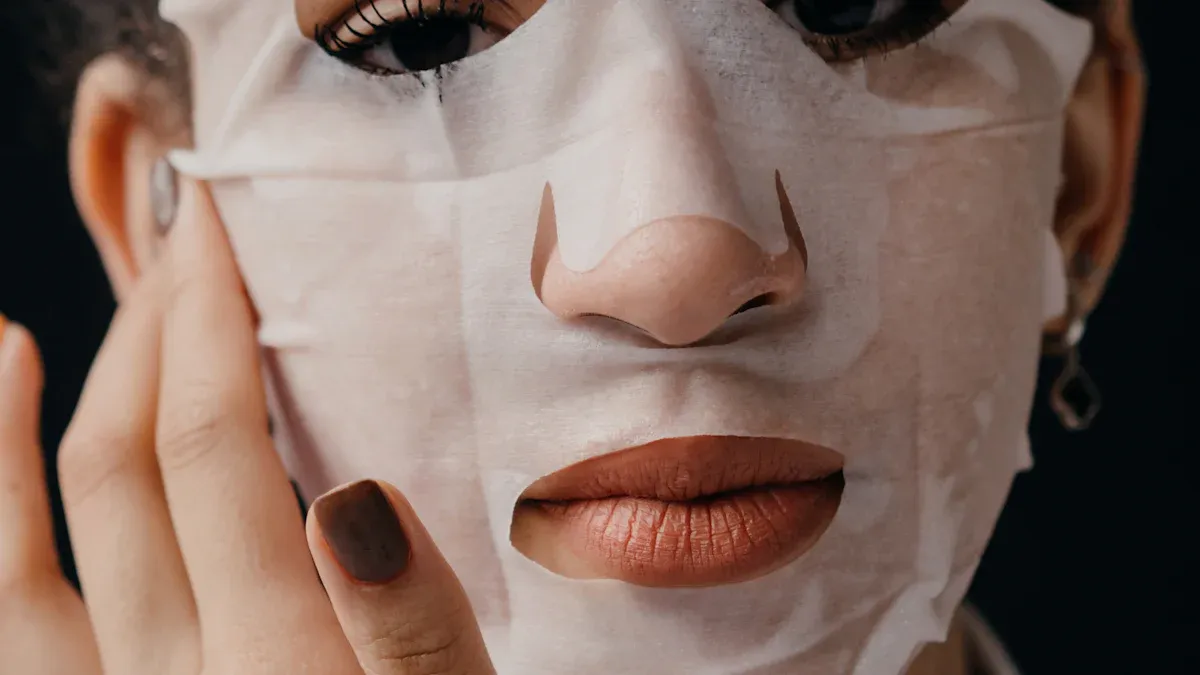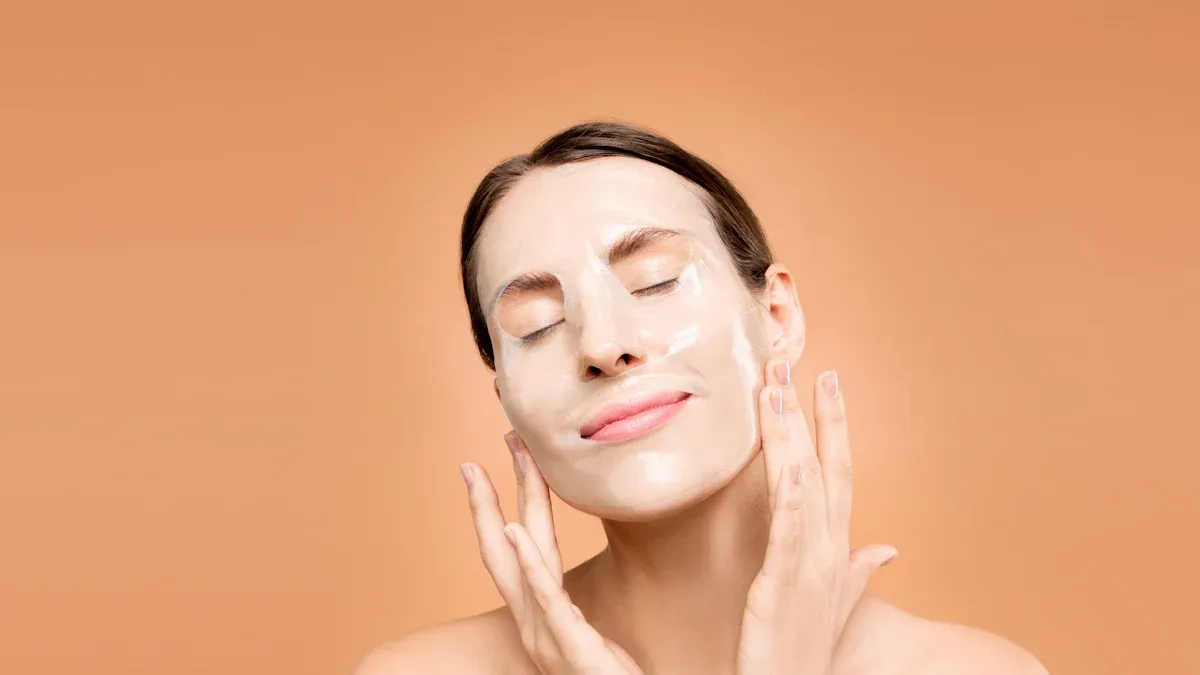
Before a face mask, it's essential to wash your face first. Exfoliate your skin to achieve the best results. Always apply moisturizer after using a mask. Good masks, like those produced with Wejing's Facial Mask Packing Machine, significantly enhance your skincare routine. Studies show these masks improve your skin's hydration, elasticity, and firmness:
Metric | Improvement (%) |
Skin Hydration (1 application) | 51.22 |
Skin Elasticity Increase (28 days) | 17.31 |
Continue your routine to achieve glowing skin.
Key Takeaways
Always cleanse your skin before applying a face mask. This removes dirt and allows the mask to work better.
Use a toner after your mask to balance your skin's pH. This helps your skin stay healthy and hydrated.
Always apply moisturizer after a mask. This locks in moisture and keeps your skin soft and glowing.
Before a Face Mask
Cleanse Your Skin
You want your skin to be clean and dry before a face mask. Start with a good cleanse to remove dirt, makeup, and oil. If you wear sunscreen or makeup, try a double cleanse. First, use a micellar water cleanser to attract makeup and sunscreen particles. Then, follow up with a gentle cleanser like Cetaphil Gentle Cleanser. This routine helps your skin absorb the mask better and keeps pores clear.
Here's why cleansing matters before a face mask:
Cleansing gets rid of impurities and old skin cells.
It lowers sebum, which can clog pores and cause breakouts.
A good cleanse lets exfoliants and masks work deeper.
When you properly prep your skin before masking, you set the stage for the mask's ingredients to do their job. High-quality masks, especially those packed with Wejing's Facial Mask Packing Machine, deliver even better results when your skin is clean.
Exfoliate Gently
You don't want dead skin cells blocking the mask's benefits. Exfoliate gently before a face mask to help your skin glow. Use a mild scrub or a chemical exfoliant, but don't overdo it. Scrubbing too hard can irritate your skin.
Why exfoliate before a face mask?
Gentle exfoliation removes dead skin cells and impurities.
It boosts microcirculation, making your skin look brighter.
Exfoliating helps your skin regenerate, so the mask works better.
Tip: If your skin feels sensitive, skip exfoliation and just cleanse. Always listen to your skin.
Prep with Toner
After cleansing and exfoliating, reach for a toner. Toner balances your skin's pH and removes leftover impurities. Experts say toner prepares your skin for active ingredients in the mask. When you apply toner while your skin is still damp, it locks in moisture and gets your skin ready for the next step.
“Spritzing the skin with the appropriate toner for your skin type and skin concerns balances the pH of the skin and maximizes absorption of the key ingredients of whichever mask you will apply next.” –Teresa Stenzel, Bioelements Director of Education
Toner can soothe your skin, get rid of excess oil, and act as a priming mist. Applying toner first is like giving your face a clean canvas. It helps the mask's ingredients penetrate deeper, so you get the most out of your face mask.
When you follow these steps before a face mask, you help your skin absorb all the good stuff.
How to Apply a Facial Mask
Choose the Right Mask
Picking the right mask makes a big difference for your skin. You want to match your mask to your skin type and your goals. Here are some tips to help you choose:
Oily skin? Try clay masks to control oil and shrink pores.
Dry skin? Cream masks or hydrating sheet masks add moisture.
Combination skin? Use gel masks for oily spots and cream masks for dry areas.
Sensitive skin? Go for gentle gel or cream masks with calming ingredients like chamomile, oatmeal, or cucumber. Avoid masks with fragrances, alcohol, or synthetic additives.
Mature skin? Cream or overnight masks with peptides and ceramides help nourish your skin.
If you have combination skin, you can even multi-mask. That means you use different masks on different parts of your face.
Apply Evenly
Now, let's talk about how to apply a facial mask. Start with clean, toned skin. Use your fingers or a brush to apply a face mask in a thin, even layer. Cover your face, neck, and even your décolleté, but skip your eyes and lips. Here's a simple step-by-step guide:
Cleanse and tone your skin.
Apply the mask evenly over your face, neck, and décolleté.
Let the mask sit for the recommended time.
Use a cool, damp cloth to remove the mask.
Pat your skin dry and follow up with moisturizer.
Masks packed with advanced technology, like those made with Wejing's Facial Mask Packing Machine, give you a consistent and safe experience every time.
Timing Matters
Leaving your mask on for the right amount of time is important. Too short, and you miss out on the benefits. Too long, and your skin might get irritated. Check the table below for how long to leave different masks on:
Mask Type | Recommended Duration |
Sheet masks | 15-20 minutes |
Clay masks | 10-15 minutes or until dry |
Overnight masks | Leave on overnight |
Jelly masks | 10-15 minutes |
Always follow the instructions on your mask. During masking, relax and let the ingredients do their work. When you use masks produced with advanced packing machines, you know you're getting a product that's safe and consistent every time.
After a Face Mask
Rinse or Remove Carefully
You just finished using your face mask. Now, you need to take it off the right way. If you used a sheet mask, peel it off gently and throw it away. For clay or cream masks, rinse your face with warm water. Use your hands or a soft cloth to help. Do not scrub or rub your skin hard. Pat your face dry with a clean towel. This helps your skin stay calm and ready for the next step.
Tip: Always read the instructions on your mask. Some masks need rinsing, and some only need peeling. Following the directions helps you get the best results from your face mask.
Use Toner
After your mask, your skin needs to feel balanced. Toner helps bring your skin's pH back to normal. Pick a toner that matches your skin's needs. Alcohol-free toners are best because they add moisture and calm your skin.
Here's why toner is important after a face mask:
A good toner helps your skin's pH after using a mask.
Toners without alcohol help your skin get back its pH after cleansing.
A balancing toner quickly brings your skin's pH to the right level, which is important for your skin's barrier.
Toners help your skin keep its natural acid layer, so it can hold moisture better.
A balancing toner is needed to fix your skin's pH after cleansing, which is important for healthy skin.
Using a toner made for your skin type after cleansing helps your skin's pH balance.
This step keeps your skin healthy and helps you get the most from your routine.
Moisturize After Face Mask
You should always use moisturizer after a face mask. This step locks in water and keeps your skin soft. Studies show that moisturizer helps your skin heal after using a mask. It lowers redness and adds more moisture.
Evidence Type | Findings | Statistical Significance |
TEWL Comparison | TEWL was much higher after 4 hours of wearing a mask than before, but much lower after using moisturizer. | p < 0.05 |
Moisture Levels | Moisture at 2.5 mm was much lower after 4 hours of wearing a mask, but went up after using moisturizer. | p < 0.05 |
Skin Redness | Skin redness and TEWL went up after using a mask, but got much better after using moisturizer. | p < 0.05 |
Pick a moisturizer that fits your skin's needs. Here's a quick guide:
Skin Concern | Recommended Ingredients | Product Type |
Dryness | Ceramides, Hyaluronic Acid | Lightweight, oil-free moisturizer |
Acne | Non-comedogenic, Niacinamide | Gentle moisturizer |
Sensitivity | Soothing ingredients | Non-greasy moisturizer |
Even if you use a hydrating face mask, you still need moisturizer. This step keeps all the good things in your skin and makes it glow. Always make this part of your skincare routine.
Add Serums or Treatments
After you use a mask and moisturizer, you can use serums or special treatments. These products help with certain skin problems. Serums soak in fast and bring strong ingredients deep into your skin.
Here's what serums can do for you:
Deep hydration makes your skin look full.
Anti-aging helps fight wrinkles and boosts collagen.
Brightening helps fade dark spots and evens your skin tone.
Better texture makes your skin feel smooth.
Targeted treatment helps with acne, redness, or other problems.
Quick absorption makes your routine faster.
More collagen helps your skin stretch better.
Smaller pores make your skin look smooth.
Protection from the environment keeps your skin safe.
You can mix and match serums for your needs.
Pick a serum that matches your skin's needs. Vitamin C, hyaluronic acid, or retinol are good choices. Add this step to your routine to get the most from your face mask.
Note: Always use serums before thicker creams. This helps your skin soak up the active ingredients better.
After using a mask, your routine should always have toner, moisturizer, and special treatments. This helps your skin stay healthy, hydrated, and glowing.
Face Mask Tips
Frequency of Use
You might wonder how often you should use a face mask. Most dermatologists say once or twice a week works best for most people. If you pick a mask for exfoliation or anti-aging, stick to this schedule to avoid irritating your skin. Using a face mask too often can dry out your skin or cause redness. Make it part of your self-care routine, but don't overdo it. Always follow the instructions on the package for the best results.
Use a face mask once or twice a week.
Masks for special concerns, like exfoliation, should not be used more than twice weekly.
Follow proper application steps to get the most out of your skincare.
Common Mistakes
Many people make simple mistakes when using a face mask. Here are some things to watch out for:
Wearing the mask the wrong way. Make sure it covers your face well.
Taking off the mask incorrectly. Remove it gently without pulling or tugging.
Touching your mask too much. Try not to touch your face while the mask is on.
Pulling down the mask to talk. Keep it in place until you finish.
Forgetting to wash your hands before and after using a face mask.
Tip: Clean hands and careful handling help keep your skin healthy and your mask effective.
Adjust for Mask Type
Not all masks work the same way. You need to adjust your routine based on the type of face mask you use.
Sheet masks: Peel off and gently pat the extra serum into your skin.
Rinse-off masks: Wash off with lukewarm water to remove all the product.
Exfoliating masks: Use these less often to protect your skin from over-exfoliation.
Choosing the right mask and using it the right way helps you get the most from your self-care and skincare routine.
Conclusion
You get the best results when you follow each step before and after your face mask. Check out these results:
Outcome | Recommended Routine | Skipping Steps |
Skin barrier improved | Yes | No |
Firmness | Yes | No |
Try these tips for your mask routine:
Pick a mask for your skin's needs.
Use a face mask regularly.
Small changes help your mask work better.
FAQ
How long should you leave a face mask on?
Check the package for the best time. Most masks work well in 10–20 minutes. Don't leave it on too long or your skin might get dry.
Can you use a face mask every day?
No, you shouldn't use a face mask every day. Most people see the best results with one or two masks each week.
What should you do if your skin feels irritated after a mask?
Stop using the mask right away. Rinse your face with cool water. Use a gentle moisturizer. If your skin still feels bad, talk to a dermatologist.























